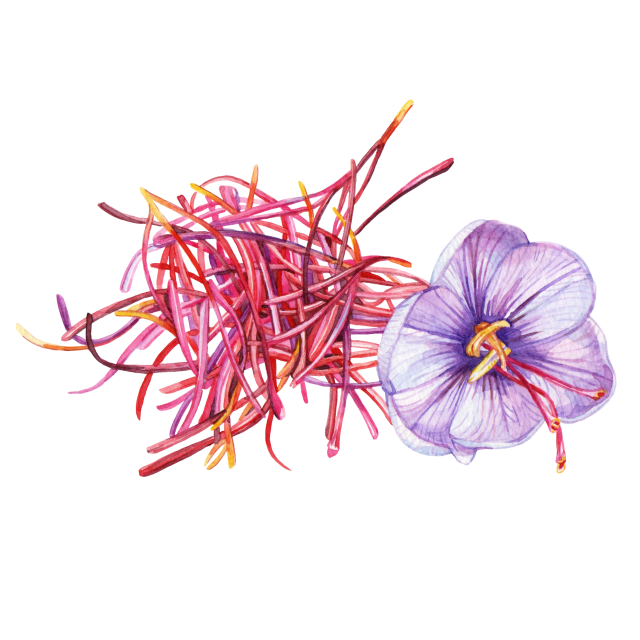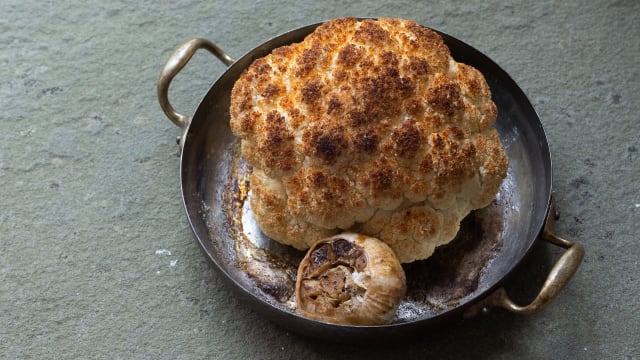
Kundan Kaliya

Kundan Kaliya
Description
Kaliya is a classic dish from Rampur, North India, mentioned in a Mughal-era cookbook. This soupy, turmeric-hued gravy was traditionally made with meat, but I prefer a simpler version with chickpeas and cauliflower. Saffron, turmeric, and yellow chile provide anti-inflammatory benefits, while chickpeas and cauliflower add fiber for gut health. Choline in chickpeas supports brain function.
Ingredients
4 to 6 SERVES
- ½ cup (100 g) chickpeas, soaked for eight hours or overnight
- 2 tsp salt
- 200 g cauliflower florets
- Water
- 3-4 (240 g) medium white or red onions, peeled and quartered
- 2 Tbsp (25 g) ghee
- 3 green cardamom pods
- ½ a blade of mace
- 2 black cardamom pods
- 3-inch-long cinnamon stick
- 1 tsp black peppercorns, lightly crushed
- 3 to 4 cloves
- 4 tsp (20 g) ginger-garlic water (see Level Up) or paste
- ½ cup (100 g) dahi or yogurt, whisked
- 1 tsp turmeric powder
- 1 tsp red chili powder
- 1 tsp yellow chili powder (optional)
- 8 to 10 saffron strands, soaked in 1 tsp warm milk
- 1 nimbu (Indian lime) or lemon for juice
- Dill or mint leaves to garnish
Directions
-
Step 1
Drain the soaked chickpeas and cook in an instant pot or a pressure cooker with 1 tsp salt and enough water to cover. If using a pressure cooker, seal the lid and bring the pot to full pressure until the first whistle releases steam. Then turn the heat to medium-low and cook for 10-15 minutes or three whistles. Allow the pressure to release completely before taking off the lid. Scoop out the chickpeas into a bowl with a ladle or a slotted spoon and reserve the liquid. Omit this step if using canned chickpeas. -
Step 2
Add the cauliflower florets to the reserved chickpea water and cook uncovered over medium heat for 5 minutes. (If using canned chickpeas, boil the cauliflower in plain water or vegetable stock). Strain and reserve the water for later to thin the gravy. -
Step 3
Add the onions to food processor or blender and grind to a coarse paste. -
Step 4
Heat the ghee in a heavy bottom kadhai or a skillet. Add the green cardamom, mace, black cardamom, cinnamon, peppercorns, and cloves. Sizzle the whole spices on medium heat for about a minute or until aromatic. -
Step 5
Add the ginger-garlic juice and sauté for a minute while stirring continuously, until the raw smells of ginger and garlic change to a rich alliaceous aroma. Add the onion paste, and the remaining 1 tsp salt, and cook for 7 to 8 minutes on medium-low heat while occasionally stirring, till the onion paste turns a light caramel color. -
Step 6
Reduce the heat to low and stir in the yogurt. Simmer for 5 minutes, stirring continuously. -
Step 7
Add the turmeric and the red and yellow (if using) chili powder. Stir and cook on medium heat for a minute, then add 2 cups of the reserved water. Cover and simmer for 10 minutes. -
Step 8
Add the chickpeas and cauliflower, along with the saffron-infused milk. Adjust the seasoning and simmer for 10 minutes to finish. Ladle the kundan kaliya into a serving bowl, squeeze some lime juice, and garnish with dill or fresh mint before serving warm with rice or dal pulao (lentil and rice pilaf).
Explore Recipe Ingredients
About the author
More by Sadaf Hussain

Curd Brine Pickle
In this delicious probiotic pickle, carrots and radishes are fermented in a yogurt and mustard brine.

Everyday Indian Gravies
Explore the building blocks of Indian cuisine through five masalas.

Homestyle Mango Pickle
Bottle the mouth-puckering flavor and myriad health benefits of green, unripe mangoes in this classic Indian summer pickle.







